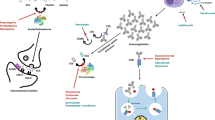Abstract
Myasthenia gravis (MG) is an autoimmune disease characterised by the presence of acetylcholine receptor antibodies and by blocking the transmission of the signal in the neuromuscular junction causing muscle weakness. It can be associated with several autoimmune diseases and certain drugs, between them Etanercept an anti-tumour necrosis factor (TNF) agent. A 42-year-old woman with rheumatoid arthritis (RA) refractory to methotrexate, was treated with adalimumab (ADA), a human monoclonal antibody against the TNF, in a dosage scheme of 40 mg every 14 days subcutaneously. The patient responded well to ADA therapy with sustained remission for 18 months when she developed blurred vision and eyelid ptosis of the left eye. The diagnosis of ocular MG was made. ADA has been discontinued and she started a treatment with pyridostigmine showing an excellent response and complete remission within a 2-month period. This is the first report making an association of ADA and ocular MG. Thus, rheumatologists dealing with patients treated with TNF inhibitors should be aware of the possible development of neurological adverse events, among them MG.

Similar content being viewed by others
References
Burmester GR, Feist E, Dorner T (2014) Emerging cell and cytokine targets in rheumatoid arthritis. Nat Rev Rheumatol 10:77–88. https://doi.org/10.1038/nrrheum.2013
Her M, Kavanaugh A (2016) Alterations in immune function with biologic autoimmune disease. J Allergy Clin Immunol 137:19–27. https://doi.org/10.1016/j.jaci.2015.10.023
Binks S, Vincent A, Palace J (2016) Myasthenia gravis: a clinical-immunological update. J Neurol 263:826–834. https://doi.org/10.1007/s00415-015-7963
Mantegazza R, Bernasconi P, Cavalcante P (2018) Myasthenia gravis: from autoantibodies to therapy. Curr Opin Neurol 31:517–525. https://doi.org/10.1097/WCO.0000000000000596
Gwathmey KG, Burns TM (2015) Myasthenia Gravis. Semin Neurol 35:327–339. https://doi.org/10.1055/s-0035-1558975
Gilhus NE, Verschuuren JJ (2015) Myasthenia gravis: subgroup classification and therapeutic strategies. Lancet Neurol 14:1023–1036. https://doi.org/10.1016/S1474-4422(15)00145-3
Smolen JS, Landewe R, Bijlsma J, Burmester G, Chatzidionysiou K et al (2017) EULAR recommendations for the management of rheumatoid arthritis with synthetic and biological disease-modifying antirheumatic drugs: 2016 update. Ann Rheum Dis 76:960–977. https://doi.org/10.1136/annrheumdis-2016-210715
Fee DB, Kasarskis EJ (2009) Myasthenia gravis associated with etanercept therapy. Muscle Nerve 39:866–870. https://doi.org/10.1002/mus.21280
Gasparyan AY, Ayvazyan L, Blackmore H, Kitas GD (2011) Writing a narrative biomedical review: considerations for authors, peer reviewers, and editors. Rheumatol Int 31:1409–1417. https://doi.org/10.1007/s00296-011-1999-3
Aletaha D, Neogi T, Silman AJ, Funovits J, Felson DT et al (2010) 2010 rheumatoid arthritis classification criteria: an American College of Rheumatology/European League Against Rheumatism collaborative initiative. Ann Rheum Dis 69:1580–1588. https://doi.org/10.1136/ard.2010.138461
Sieb JP (2014) Myasthenia gravis: an update for the clinician. Clin Exp Immunol 175:408–418. https://doi.org/10.1111/cei.12217
Kaltsonoudis E, Voulgari PV, Konitsiotis S, Drosos AA (2014) Demyelination and other neurological adverse events after anti-TNF therapy. Autoimmun Rev 13:54–58. https://doi.org/10.1016/j.autrev.2013.09.002
Kaltsonoudis E, Zikou AK, Voulgari PV, Konistsiotis S, Argyropoulou MI, Drosos AA (2014) Neurological adverse events in patients receiving anti-TNF therapy: a prospective imaging and electrophysiological study. Arthritis Res Ther 16:R125. https://doi.org/10.1186/ar4582
Kakoulidou M, Bjelak S, Pirskanen-Matell R, Lefvert AK (2007) A clinical and immunological study of a myasthenia gravis patient treated with infliximab. Acta Neurol Scand 115:279–283. https://doi.org/10.1111/j.1600-0404.2006.00778.x
Tüzün E, Meriggioli MN, Rowin J, Yang H, Christadoss P (2005) Myasthenia gravis patients with low plasma IL-6 and IFN-gamma benefit from etanercept treatment. J Autoimmun 24:261–268. https://doi.org/10.1016/j.jaut.2005.01.013
Rowin J, Meriggioli MN, Tüzün E, Leurgans S, Christadoss P (2004) Etanercept treatment in corticosteroid-dependent myasthenia gravis. Neurology 63:2390–2392. https://doi.org/10.1212/01.wnl.0000147242.92691.71
Rowin J (2008) Etanercept treatment in myasthenia gravis. Ann NY Acad Sci 1132:300–304. https://doi.org/10.1196/annals.1405.028
Lee JS, Joo IS, Seok JI (2009) Widely varying TNF-alpha levels in patients with myasthenia gravis. Neurol Sci 30:259–262. https://doi.org/10.1007/s10072-009-0023-0
Al-Haidar M, Benatar M, Kaminski HJ (2018) Ocular myasthenia. Neurol Clin 36:241–251. https://doi.org/10.1016/j.ncl.2018.01.003
Aguirre F, Villa AM (2018) Prognosis of ocular myasthenia gravis in an Argentinian population. Eur Neurol 79:113–117. https://doi.org/10.1159/000487132
Funding
This study was not funded by any means.
Author information
Authors and Affiliations
Contributions
All authors contributed equally to this manuscript. EP (also drafting of the manuscript), TM, and TEM searched the literature and PVV, and AAD reviewed critically and corrected the manuscript. Contributors’ statement all authors approved the final manuscript as submitted and agree to be accountable for all aspects of the work.
Corresponding author
Ethics declarations
Conflict of interest
The authors (Pelechas, Memi, Markatseli, Voulgari, Drosos) have no conflict of interest.
Ethics approval
This case is complying with the ethical standards of the University Hospital of Ioannina as it has been obtained an informed consent from the presented patient (informed consent has been uploaded as a different file—supplementary material).
Additional information
Publisher's Note
Springer Nature remains neutral with regard to jurisdictional claims in published maps and institutional affiliations.
Rights and permissions
About this article
Cite this article
Pelechas, E., Memi, T., Markatseli, T.E. et al. Adalimumab-induced myasthenia gravis: case-based review. Rheumatol Int 40, 1891–1894 (2020). https://doi.org/10.1007/s00296-020-04587-4
Received:
Accepted:
Published:
Issue Date:
DOI: https://doi.org/10.1007/s00296-020-04587-4




